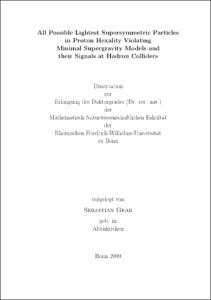Grab, Sebastian: All Possible Lightest Supersymmetric Particles in Proton Hexality Violating Minimal Supergravity Models and their Signals at Hadron Colliders. - Bonn, 2009. - Dissertation, Rheinische Friedrich-Wilhelms-Universität Bonn.
Online-Ausgabe in bonndoc: https://nbn-resolving.org/urn:nbn:de:hbz:5N-18179
Online-Ausgabe in bonndoc: https://nbn-resolving.org/urn:nbn:de:hbz:5N-18179
@phdthesis{handle:20.500.11811/4099,
urn: https://nbn-resolving.org/urn:nbn:de:hbz:5N-18179,
author = {{Sebastian Grab}},
title = {All Possible Lightest Supersymmetric Particles in Proton Hexality Violating Minimal Supergravity Models and their Signals at Hadron Colliders},
school = {Rheinische Friedrich-Wilhelms-Universität Bonn},
year = 2009,
month = jul,
note = {The most widely studied supersymmetric scenario is the minimal supersymmetric standard model (MSSM) with more than a hundred free parameters. However for detailed phenomenological studies, the minimal supergravity (mSUGRA) model, a restricted and well-motivated framework for the MSSM, is more convenient. In this model, lepton- and baryon-number violating interactions are suppressed by a discrete symmetry, R-parity or proton-hexality, to keep the proton stable. However, it is sufficient to forbid only lepton- or baryon number violation. We thus extend mSUGRA models by adding a proton-hexality violating operator at the grand unification scale.
This can change the supersymmetric spectrum leading on the one hand to a sneutrino, smuon or squark as the lightest supersymmetric particle (LSP). On the other hand, a wide parameter region is reopened, where the scalar tau (stau) is the LSP. We investigate in detail the conditions leading to non-neutralino LSP scenarios. We take into account the restrictions from neutrino masses, the muon anomalous magnetic moment, b -> s gamma, and other precision measurements. We furthermore investigate existing restrictions from direct searches at LEP, the Tevatron, and the CERN proton-antiproton collider.
It is vital to know the nature of the LSP, since supersymmetric particles normally cascade decay down to the LSP at collider experiments. We present typical LHC signatures for sneutrino LSP scenarios. Promising signatures are high-pT muons and jets, like-sign muon events and detached vertices from long lived taus. We also classify the stau LSP decays and describe their dependence on the mSUGRA parameters. We then exploit our results for resonant single slepton production at the LHC. We find novel signatures with like-sign muon and three- and four-muon final states. Finally, we perform a detailed analysis for single slepton production in association with a single top quark. We show that the signal can be distinguished from the background at the LHC.},
url = {https://hdl.handle.net/20.500.11811/4099}
}
urn: https://nbn-resolving.org/urn:nbn:de:hbz:5N-18179,
author = {{Sebastian Grab}},
title = {All Possible Lightest Supersymmetric Particles in Proton Hexality Violating Minimal Supergravity Models and their Signals at Hadron Colliders},
school = {Rheinische Friedrich-Wilhelms-Universität Bonn},
year = 2009,
month = jul,
note = {The most widely studied supersymmetric scenario is the minimal supersymmetric standard model (MSSM) with more than a hundred free parameters. However for detailed phenomenological studies, the minimal supergravity (mSUGRA) model, a restricted and well-motivated framework for the MSSM, is more convenient. In this model, lepton- and baryon-number violating interactions are suppressed by a discrete symmetry, R-parity or proton-hexality, to keep the proton stable. However, it is sufficient to forbid only lepton- or baryon number violation. We thus extend mSUGRA models by adding a proton-hexality violating operator at the grand unification scale.
This can change the supersymmetric spectrum leading on the one hand to a sneutrino, smuon or squark as the lightest supersymmetric particle (LSP). On the other hand, a wide parameter region is reopened, where the scalar tau (stau) is the LSP. We investigate in detail the conditions leading to non-neutralino LSP scenarios. We take into account the restrictions from neutrino masses, the muon anomalous magnetic moment, b -> s gamma, and other precision measurements. We furthermore investigate existing restrictions from direct searches at LEP, the Tevatron, and the CERN proton-antiproton collider.
It is vital to know the nature of the LSP, since supersymmetric particles normally cascade decay down to the LSP at collider experiments. We present typical LHC signatures for sneutrino LSP scenarios. Promising signatures are high-pT muons and jets, like-sign muon events and detached vertices from long lived taus. We also classify the stau LSP decays and describe their dependence on the mSUGRA parameters. We then exploit our results for resonant single slepton production at the LHC. We find novel signatures with like-sign muon and three- and four-muon final states. Finally, we perform a detailed analysis for single slepton production in association with a single top quark. We show that the signal can be distinguished from the background at the LHC.},
url = {https://hdl.handle.net/20.500.11811/4099}
}






